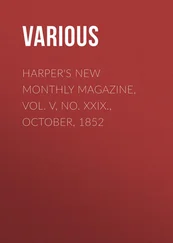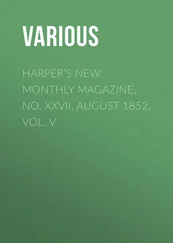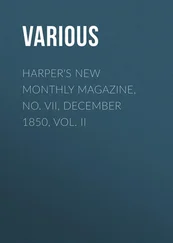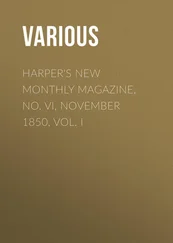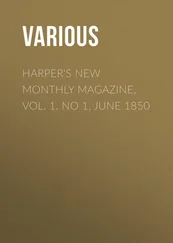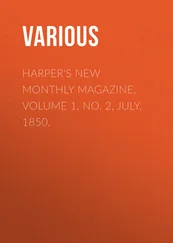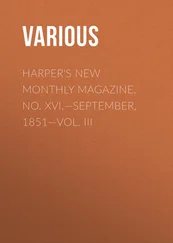Various - Harper's New Monthly Magazine, No. XXVI, July 1852, Vol. V
Здесь есть возможность читать онлайн «Various - Harper's New Monthly Magazine, No. XXVI, July 1852, Vol. V» — ознакомительный отрывок электронной книги совершенно бесплатно, а после прочтения отрывка купить полную версию. В некоторых случаях можно слушать аудио, скачать через торрент в формате fb2 и присутствует краткое содержание. Издательство: Иностранный паблик, Жанр: periodic, foreign_edu, на английском языке. Описание произведения, (предисловие) а так же отзывы посетителей доступны на портале библиотеки ЛибКат.
- Название:Harper's New Monthly Magazine, No. XXVI, July 1852, Vol. V
- Автор:
- Издательство:Иностранный паблик
- Жанр:
- Год:неизвестен
- ISBN:нет данных
- Рейтинг книги:4 / 5. Голосов: 1
-
Избранное:Добавить в избранное
- Отзывы:
-
Ваша оценка:
- 80
- 1
- 2
- 3
- 4
- 5
Harper's New Monthly Magazine, No. XXVI, July 1852, Vol. V: краткое содержание, описание и аннотация
Предлагаем к чтению аннотацию, описание, краткое содержание или предисловие (зависит от того, что написал сам автор книги «Harper's New Monthly Magazine, No. XXVI, July 1852, Vol. V»). Если вы не нашли необходимую информацию о книге — напишите в комментариях, мы постараемся отыскать её.
Harper's New Monthly Magazine, No. XXVI, July 1852, Vol. V — читать онлайн ознакомительный отрывок
Ниже представлен текст книги, разбитый по страницам. Система сохранения места последней прочитанной страницы, позволяет с удобством читать онлайн бесплатно книгу «Harper's New Monthly Magazine, No. XXVI, July 1852, Vol. V», без необходимости каждый раз заново искать на чём Вы остановились. Поставьте закладку, и сможете в любой момент перейти на страницу, на которой закончили чтение.
Интервал:
Закладка:
The component parts of the musket are all made according to one precise pattern, and thus when taken up at random they are sure to come properly together. There is no individual fitting required in each particular case. Any barrel will fit into any stock, and a screw designed for a particular plate or band, will enter the proper hole in any plate or band of a hundred thousand. There are many advantages which result from this precise conformity to an established pattern in the components of the musket. In the first place the work of manufacturing it is more easily performed in this way. It is always the tendency of machinery to produce similarity in its results, and thus although where only two things are to be made it is very difficult to get them alike, the case is very different where there is a call for two hundred thousand. In this last case it is far easier and cheaper to have them alike than to have them different; for in manufacturing on such a scale a machinery is employed, which results in fashioning every one of its products on the precise model to which the inventor adapted the construction of it. Then, besides, a great convenience and economy results from this identity of form in the component parts of the musket, when the arms are employed in service. Spare screws, locks, bands, springs, &c., can be furnished in quantities, and sent to any remote part of the country wherever they are required; so that when any part of a soldier's gun becomes injured or broken, its place can be immediately supplied by a new piece, which is sure to fit as perfectly into the vacancy as the original occupant. Even after a battle there is nothing to prevent the surviving soldiers from making up themselves, out of a hundred broken and dismantled muskets, fifty good ones as complete and sound as ever, by rejecting what is damaged, and assembling the uninjured parts anew.
To facilitate such operations as these the mechanism by which the various parts of the musket are attached to each other and secured in their places, is studiously contrived with a view to facilitating in the highest degree the taking of them apart, and putting them together. Each soldier to whom a musket is served is provided with a little tool, which, though very simple in its construction, consists of several parts and is adapted to the performance of several functions. With the assistance of this tool the soldier sitting on the bank by the roadside, at a pause in the middle of his march, if the regulations of the service would allow him to do so, might separate his gun into its forty-seven components, and spread the parts out upon the grass around him. Then if any part was doubtful he could examine it. If any was broken he could replace it – and after having finished his inspection he could reconstruct the mechanism, and march on as before.
It results from this system that to make any change, however slight, in the pattern of the musket or in the form of any of the parts of it, is attended with great difficulty and expense. The fashion and form of every one of the component portions of the arm, are very exactly and rigidly determined by the machinery that is employed in making it, and any alteration, however apparently insignificant, would require a change in this machinery. It becomes necessary, therefore, that the precise pattern both of the whole musket and of all of its parts, once fixed, should remain permanently the same.
The most costly of the parts which lie before the workman in assembling the musket is the barrel. The value of it complete is three dollars. From the barrel we go down by a gradually descending scale to the piece of smallest value, which is a little wire called the ramrod spring wire – the value of which is only one mill; that is the workman is paid only one dollar a thousand for the manufacture of it. The time expended in assembling a musket is about ten minutes, and the price paid for the work is four cents.
THE ARSENAL
The New Arsenal, which has already been alluded to in the description of the general view of the Arsenal grounds, is a very stately edifice. It is two hundred feet long, seventy feet wide, and fifty feet high. It is divided into three stories, each of which is calculated to contain one hundred thousand muskets, making three hundred thousand in all. The muskets when stored in this arsenal are arranged in racks set up for the purpose along the immense halls, where they stand upright in rows, with the glittering bayonets shooting up, as it were, above. The visitors who go into the arsenal walk up and down the aisles which separate the ranges of racks, admiring the symmetry and splendor of the display.
The Arsenal has another charm for visitors besides the beauty of the spectacle which the interior presents – and that is the magnificent panorama of the surrounding country, which is seen from the summit of the tower. This tower, which occupies the centre of the building, is about ninety feet high – and as it is about thirty feet square, the deck at the top furnishes space for a large party of visitors to stand and survey the surrounding country. Nothing can be imagined more enchanting than the view presented from this position in the month of June. The Armory grounds upon one side, and the streets of the town upon the other lie, as it were, at the feet of the spectator, while in the distance the broad and luxuriant valley of the Connecticut is spread out to view, with its villages, its fields, its groves, its bridges, its winding railways, and its serpentine and beautiful streams.
THE ADMINISTRATION OF THE ARMORY
The manufacture of muskets being a work that pertains in some sense to the operations of the army, should be, for that reason, under military rule. On the other hand, inasmuch as it is wholly a work of mechanical and peaceful industry, a civil administration would seem to be most appropriate for it. There is, in fact, a standing dispute on this subject both in relation to the Armory at Springfield and to that at Harper's Ferry, among those interested in the establishments, and it is a dispute which, perhaps, will never be finally settled. The Springfield Armory is at this time under military rule – the present commanding officer, Colonel Ripley, having been put in charge of it about ten years ago, previous to which time it was under civil superintendence. At the time of Col. Ripley's appointment the works, as is universally acknowledged, were in a very imperfect condition, compared with the present state. On entering upon the duties of his office, the new incumbent engaged in the work of improvement with great resolution and energy, and after contending for several years with the usual obstacles and difficulties which men have to encounter in efforts at progress and reform, he succeeded in bringing the establishment up to a state of very high perfection; and now the order, the system, the neatness, the almost military exactness and decorum which pervade every department of the works are the theme of universal admiration. The grounds are kept in the most perfect condition – the shops are bright and cheerful, the walls and floors are every where neat and clean, the machinery and tools are perfect, and are all symmetrically and admirably arranged, while the workmen are well dressed, and are characterized by an air of manliness, intelligence, and thrift, that suggests to the mind of the visitor the idea of amateur mechanics, working with beautiful tools, for pleasure.
And yet the men at first complained, sometimes, of the stringency of rules and regulations required to produce these results. These rules are still in force, though now they are very generally acquiesced in. No newspapers of any kind can be taken into the shops, no tobacco or intoxicating drinks can be used there, no unnecessary conversation is allowed, and the regulations in respect to hours of attendance, and to responsibility for damaged work are very definite and strict. But even if the workmen should be disposed in any case to complain of the stringency of these requirements, they can not but be proud of the result; for they take a very evident pleasure in the gratification which every visitor manifests in witnessing the system, the order, the neatness, and the precision that every where prevail.
Читать дальшеИнтервал:
Закладка:
Похожие книги на «Harper's New Monthly Magazine, No. XXVI, July 1852, Vol. V»
Представляем Вашему вниманию похожие книги на «Harper's New Monthly Magazine, No. XXVI, July 1852, Vol. V» списком для выбора. Мы отобрали схожую по названию и смыслу литературу в надежде предоставить читателям больше вариантов отыскать новые, интересные, ещё непрочитанные произведения.
Обсуждение, отзывы о книге «Harper's New Monthly Magazine, No. XXVI, July 1852, Vol. V» и просто собственные мнения читателей. Оставьте ваши комментарии, напишите, что Вы думаете о произведении, его смысле или главных героях. Укажите что конкретно понравилось, а что нет, и почему Вы так считаете.


